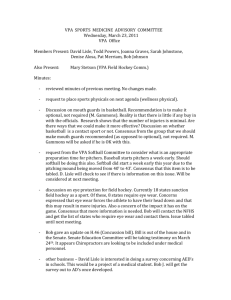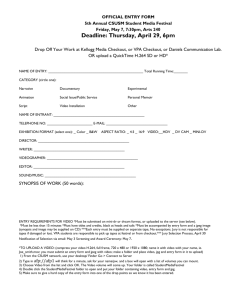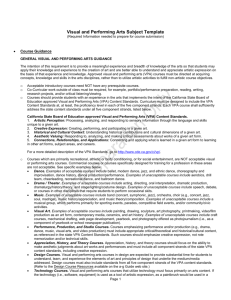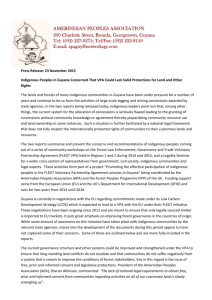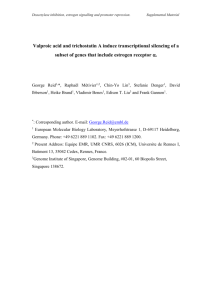Fig 4. The effect of valproic acid (100, 200 and 300 mg /kg, ip) on hot
advertisement
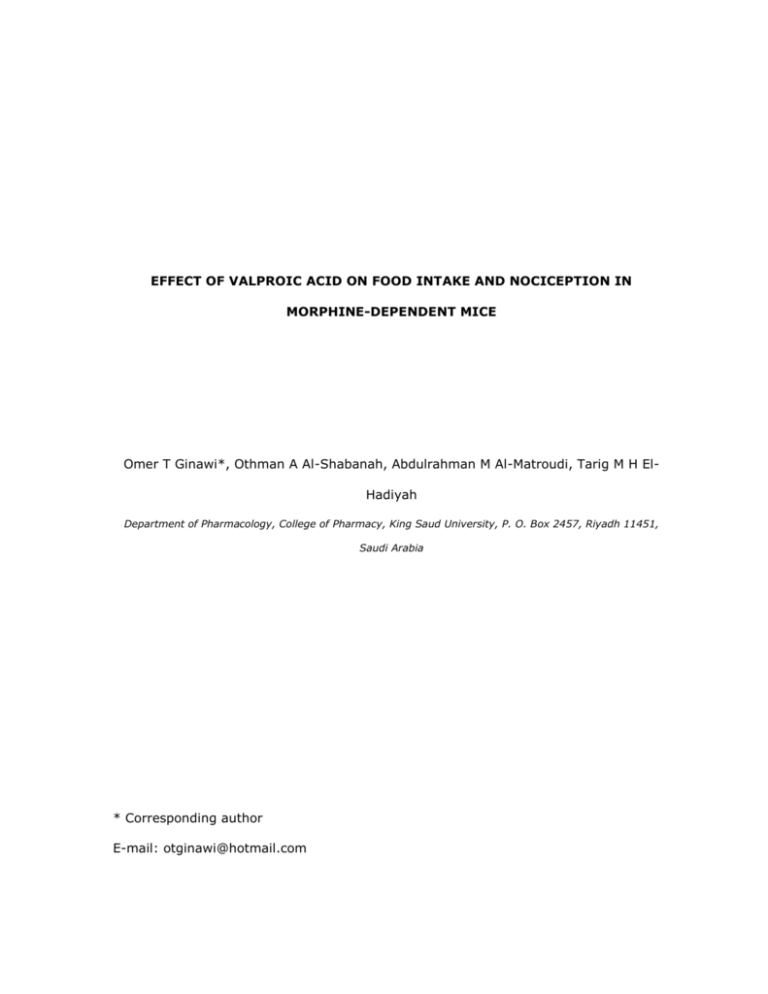
EFFECT OF VALPROIC ACID ON FOOD INTAKE AND NOCICEPTION IN MORPHINE-DEPENDENT MICE Omer T Ginawi*, Othman A Al-Shabanah, Abdulrahman M Al-Matroudi, Tarig M H ElHadiyah Department of Pharmacology, College of Pharmacy, King Saud University, P. O. Box 2457, Riyadh 11451, Saudi Arabia * Corresponding author E-mail: otginawi@hotmail.com EFFECT OF VALPROIC ACID ON FOOD INTAKE AND NOCICEPTION IN MORPHINE-DEPENDENT MICE Omer T Ginawi*, Othman A Al-Shabanah, Abdulrahman M Al-Matroudi, Tarig M H ElHadiyah Department of Pharmacology, College of Pharmacy, King Saud University, P. O. Box 2457, Riyadh 11451, Saudi Arabia Abstract The anorectic and antinociceptive effects of valproic acid (VPA) were studied in morphine-dependent mice in comparison with normal ones. For this purpose, the food intake of animals deprived of food for 24 hours and the hot plate reaction time, were studied. Morphine-dependency was induced by i.p. injections of morphine HCl (40 mg /kg; twice daily for 3 days). Morphine-dependent animals showed a significant decrease in food intake (p < 0.05), when compared with control mice (non-morphinized). Acute administration of VPA (100, 200 and 300 mg /kg, i.p.) significantly potentiated the anorexia observed in morphine-dependent mice. VPA (200 and 300 mg /kg, i.p.) alone produced a significant decrease in food intake (p < 0.05) in non-morphinized animals. In the study of antinociception, a significant increase (p < 0.001) in hot-plate latency was observed in morphine-dependent animals, as compared to control mice. Treatment with VPA alone produced a significant increase (p < 0.05) in hot-plate latency in salinepretreated animals in comparison with saline-pretreated control group. However, the administration of VPA (100 and 200 mg /kg, i.p.) to morphine-dependent animals significantly decreased (p < 0.05) their hot-plate latency as compared to the control group. In conclusion, VPA exhibited anorectic and antinociceptive activities in mice. VPA potentiated the anorexia seen in mice, which were rendered dependent to morphine, whereas the drug inhibited the antinociceptive activity observed in these mice. It seems from the present study that VPA is probably toxic in morphine-dependent subjects, since it might potentiate the anorectic and inhibit the analgesic effects. Introduction Morphine is a known drug of abuse. It is effective in most kinds of acute and chronic pain. Chronic morphine administration causes physical and psychological dependence (1). Opioid-dependent population is increasing and now it may be considered to represent a sizable proportion of patients throughout the world. Morphine-dependent subjects may use other drugs for treatment of certain ailments, or as an attempt to avoid the withdrawal syndrome from morphine, or to gain additional euphoria. Knowledge that morphine produces a large number of effects and that it interacts with a number of neurotransmitters makes probably a lot of interactions possible. The CNS is a very complex structure; therefore most of the interactions that might originate from combinations with morphine remain unknown. It seems necessary to evaluate the possible interaction that may result from the use of most groups of drugs in morphine-dependent subjects. It was found that stimulation of and opiate receptors decreases gamaaminobutyric acid (GABA) release from GABA-ergic interneurons (2, 3). Concomitant use of morphine, the well known agonist, with GABA-ergic drugs may therefore reduce the various effects of the latter drugs. In the literature, few reports are written on the effects of currently used GABA-ergic drugs in morphine-dependent subjects. Valproic acid (VPA), a GABA-ergic drug, is an oral anticonvulsant that is chemically unrelated to other anticonvulsants. It inhibits most kinds of experimentally-induced convulsions, and is effective in many kinds of epilepsy. The mechanism of action of VPA at present is not clear; but it has been postulated that the drug effects are mediated through effects on the function of brain GABA, specifically by increasing brain concentrations of this inhibitory transmitter (4, 5). GABA has been reported to participate in the feeding behaviour in rats (6, 7). Also, increased GABA level in the cerebrospinal fluid has been shown to have antinociceptive effect through GABA-B receptor stimulation at the dorsal horn of the spinal cord (8). Thus, both morphine and VPA can affect the central GABA-ergic systems. The present study was performed to study the possible interaction between morphine dependency and VPA on the food intake and antinociceptive effect of these drugs in mice. Materials and methods 1. Animals: Swiss albino male mice weighing 25-30g were used in the current study. They were obtained from the Experimental Animal Care Center, College of Pharmacy, King Saud University. The animals were housed, 8 mice per cage, under conditions of normal room temperature (21-23 C), humidity and light cycle (7 a.m. to 7 p.m.). They were given free access to food (standard lab chow, Grain Silos and Flour Mills Organization, Riyadh), and water ad libitum. 2. Drugs: The following drugs were used: morphine hydrochloride (Sandoz Ltd., Basle, Switzerland), Naloxone hydrochloride dihydrate (Fluka chemie. AG, Switzerland) and valproic acid (Sigma chemical CO., USA). All drugs were dissolved in normal saline. Doses were expressed as mg/kg body weight of the salt. Volume injected per animal was 10 ml /kg. 3. Development of dependence in animals: Animals were rendered morphine dependent by intraperitoneal injection of morphine HCl (40 mg /kg) twice daily for 3 days, according to the method of Saelens et al. (9). Morphine dependence was confirmed in a group of 15 mice by the method of naloxone withdrawal jumping. Animals, which were pretreated with morphine, were injected i.p. with 30 mg/kg of naloxone HCl, 2 hours after the last injection of morphine. The animals were individually placed in glass cylinders (diameter and height of the cylinder were 10 and 12 cm, respectively). The number of jumps by each animal was subsequently recorded for a period of 10 minutes. The number of jumps of each animal was significantly increased in comparison with the jumps registered for the control group. Animals subjected to this test were not used in subsequent experiments. 4. Treatment protocols: Animals were randomly assigned to four groups (each group consisted of 8 mice). In general, the design shown in the following table was adopted. The 2 nd treatment was given 2 h after the last injection of the pretreatment. Appropriate drug dosages were determined from pilot experiments. Animals pretreated with morphine were referred to as morphinized and animals pretreated with saline were referred to as non-morphinized. 1st treatment 2nd treatment Group (bid for 3 days, i.p.) ( acute, i.p.) Group1 (non-morphinized control) Saline Saline Group 2 (morphinized control) Morphine Saline Group 3 (non-morphinized) Saline VPA Group 4 (morphinized) Morphine VPA 5. Procedures: 5.1. Evaluation of anorectic activity: Groups of animals were deprived of food for 24 h before the experiment. The animals, however, were allowed free access to water. Each group was placed in a cage and a weighed amount of the standard lab chow (≈ 20g) was placed at the top of the animal’s cage. Reweighing of the animal’s food was done after 1, 2, 3, 4, and 5 h, in order to determine the amount of food intake by the animals in each group. The decrease in food intake was taken as an index for anorectic activity of the test drug in food-deprived mice. 5.2. Evaluation of antinociception by the hot plate method: An electrically heated hot plate was used. The temperature of the hot plate was controlled at 55 ± 1º C. Groups of 8 mice were used for each dose. The animals were individually placed on the hot plate. A stopwatch was used to record the time from placing the animal on the hot plate until the animal either licked its forepaws or jumped off the plate. The hot plate latency was recorded 30 min before and after 30, 60 and 90 min following drug administration. 6. Statistical analysis: Data were expressed as mean ± SEM. One-way ANOVA was used for statistical comparison between the means of different groups in each test. For significant results, a post-hoc comparison of any two means was made with Tukey-Kramer multiple comparisons test. All calculations were carried out using GraphPad InStat-2 software program. The level of significance was adopted at p < 0.05. Results 1. The effect of valproic acid on food intake in food-deprived non-morphinized mice: As shown in Fig 1, VPA (100 mg /kg) did not alter the food intake of food-deprived non-morphinized mice, at all time intervals. Only during the first hour after food presentation, VPA (200 mg /kg) significantly reduced (p < 0.05) the food intake of non-morphinized mice, as compared to control group (almost 50% reduction). VPA at the dose of 300 mg/kg produced significant reduction of food intake in nonmorphinized mice at 1 h (p < 0.001) and 2 h (p < 0.05) time intervals (reductions were about 31 and 38%, respectively), as compared to control animals. 2. The effect of valproic acid on food intake in food-deprived morphinized mice: From Fig 2, no change in food intake by VPA (100 mg /kg) was seen after 1, 3 and, 5 hours as compared to morphinized control. However, at 2 h VPA (100 mg /kg) caused a significant reduction (p < 0.05) in food intake and at 4 h it caused a significant increase (p < 0.05) in the food intake of morphinized groups as compared to control. VPA (200 mg /kg) significantly reduced (p < 0.01) the food intake in morphinized fooddeprived mice only at 2 h as compared to control. Also, VPA (300 mg /kg) significantly reduced food intake in morphinized groups at 1, 2 and 4 h as compared to control (p < 0.001, p < 0.01 and p < 0.01, respectively). Also, a significant increase in food intake (p < 0.05) was observed at 5 h after VPA administration. 3. The antinociceptive effect of valproic acid in non-morphinized mice: The effect of VPA (100, 200 and 300 mg /kg, i.p) administered to non-morphinized mice in the hot plate test is shown in Fig 3. VPA (100 mg /kg) significantly increased the hot plate latency at 30 and 60 min, as compared to their respective control (p < 0.01 and p < 0.05, respectively). VPA (200 mg /kg), on the other hand, did not result in any changes in nociception as compared to saline control. VPA (300 mg /kg) significantly increased the hot plate latency at 30 and 60 min, as compared to their respective control (p < 0.001 and p < 0.01, respectively). 4. The antinociceptive effect of valproic acid in morphinized mice: The effect of valproic acid in morphinized mice is shown in Fig 4. At 60 min post VPA (100 mg /kg) injection there was a significant decrease (p < 0.05) in the hot-plate latency, as compared to morphinized control. Also, VPA (200 mg /kg) significantly decreased (p < 0.05) the hot-plate latency at 30 and 60 min as compared to control. The higher dose of VPA of 300 mg /kg did not change the hot plate latency at any time intervals post its injection in morphinized mice. On the hot plate latency, the effect of VPA was greater in morphinized than nonmorphinized animals. This is indicated by the observation that the hot-plate latencies of VPA 100 and 300 mg /kg doses at 90 min time interval were significantly increased (p < 0.01) in morphinized as compared with non-morphinized mice. At 60 and 90 min, VPA 200 mg /kg significantly increased (p < 0.01) the hot plate latency of morphinized mice as compared to non-morphinized animals. Discussion In the current study, treatment with morphine, twice daily for 3 days, reduced food intake of albino male mice. This is in agreement with Buck and Marrazzi (10) and Shimomura et al. (11). Some authors, however, reported increases in food intake by chronic morphine (12). Discrepancies between their results and our results may be related to differences in species, doses, methods used to measure food intake, routes of injection and observation intervals. Of the possible mechanisms by which morphine reduces food intake is its ability to increase 5-hydroxytryptymine (5-HT) (13) and dopamine (DA) (1, 3, 14) release, which are known to be anorectic (15). It has been observed that acute VPA reduced food intake in mice in a dosedependent manner. Wolden-Hanson et al. reported that valproate induced obesity in rats (16). VPA acts through GABA, which is thought to play a role in the central regulation of feeding behaviour (17). Two reciprocal GABA-sensitive feeding systems have been suggested to exist in the hypothalamus (18). It has been demonstrated that GABA receptor agonists induce feeding in rats (19). Possibly, there are species differences between rats and mice that might contribute to the central effects of endogenous GABA on feeding behaviour. In the present study, VPA at high doses produced synergism in decreasing food intake in morphinized mice as compared to morphinized control. This could be explained by the synergism between the GABAergic and opioid systems, since each of them reduces food intake in mice. But, what is difficult to be explained is why low doses of VPA antagonize the anorectic activity of morphine as compared to morphinized control. It is known that morphine causes increased 5-HT and DA release, via inhibition of GABA release. So, the administration of an exogenous GABA potentiating agent should block morphine-induced increases of 5-HT and DA efflux. Thus, one of the possible mechanisms that could be postulated to explain the interaction of VPA and morphine is as follows: VPA increases GABA level, which may in turn block morphineinduced increases of 5-HT and DA efflux, hence leading to decreased morphine anorexia. In agreement with previous studies (20), morphine administration produced antinociception in mice. VPA also produced antinociception in mice, in agreement with previous studies (21, 22). VPA alone at the doses of 100 and 300 mg/ kg significantly increased the hot plate latency, although it failed to do so at the dose of 200 mg/ kg. These results indicate that VPA analgesic property could be dose specific, or alternatively, larger groups of animals were needed to manifest the expected antinociception by VPA 200 mg/kg. In the present study rapid onset of antinociceptive action of VPA was observed. VPA has been reported to be an inhibitor of GABA-transaminase and succinic semialdehyde dehydrogenase. Thus, increased GABA by VPA is a possible explanation for its antinociceptive action. Also, Vion-Dury et al. (22) reported that the analgesic properties of VPA might be related to activation of pro-enkephalin system in rat brain. In the present study, VPA failed to potentiate the analgesic effect of morphine in morphinized mice. On the contrary, VPA (at low doses), antagonized the analgesic effect of morphine. The manipulation of 5-HT level, by increasing or decreasing its release for example, in the CNS has been reported to affect morphine analgesia. It is known that morphine administration evokes 5-HT release in the CNS through inhibition of GABA release. Thus, the administration of an exogenous GABA-ergic drug is expected to block morphine-induced increase in 5-HT and DA efflux. Tao and Auerbach (13) have reported that muscimol (GABA-A agonist) infusion in the dorsal raphe nucleus blocked the effect of morphine sulfate (20mg/kg s.c.) on 5-HT efflux. This could be one of the possible mechanisms to explain the VPA-produced antagonism of morphine analgesia in morphinized mice. In addition, it has been reported by Baf et al. (23) that VPA significantly decreases 5-HT level in the hypothalamus and cerebellum; this is another possible mechanism to explain the antagonism of VPA to morphine analgesia. In conclusion, morphine-dependence has resulted in increased VPA anorectic activity. VPA failed to potentiate the analgesic activity observed in morphine-dependent animals. Thus, VPA is possibly a toxic drug if used in morphine addicts. This is because VPA potentiates the anorexia and inhibits the analgesia induced by morphine administration. References 1. Gutstein HB, Akil H. Opioid analgesics. In: Hardman JG, Limbird LE and Gilman AG. The Pharmacological Basis of Therapeutics. edition.Goodman and Gilman’s. McGraw-hill, 2001: 569-619. 10th 2. Cohen GA, Doze VA, Madison DV. Opioid inhibition of GABA release from presynaptic terminals of rat hippocampal interneurons. Neuron 1992, 9: 325-35. 3. Shoji Y, Delfs J, Williams JT. Presynaptic inhibition of GABA B–mediated synaptic potentials in the ventral tegmental area during morphine withdrawal. J Neurosci 1999, 19: 2347-55. 4. Beckner RR. Valproic acid. Drug Intell Clin Pharm 1979, 13: 18-21. 5. VanDongen AMJ, VanErp MG, Voskuyl RA. Valproate reduces excitability by blockage of sodium and potassium conductance. Epilepsia 1986, 27: 177- 82. 6. Stratford TR, Kelley AE. GABA in the Nucleus Accumbens Shell participates in the central regulation of feeding behavior. J Neurosci 1997, 17: 4434-40. 7. Shuye PU, Jain MR, Horvath TL, Sabrina D, Kalra PS, Kalra SP. Interaction between neuropeptide Y and γ-aminobutyric acid in stimulation of feeding: A morphological and pharmacological analysis. Endocrinol 1999, 140: 933-40. 8. Lloyd KG, Morselli PL. Psychopharmacology of GABAergic drugs. In: Psychopharmacology, The Third Generation of progress (ed. HY Meltzer), New York, Raven Press, 1987, 183-95. 9. Saelens JK, Granat JR, Sawyer WK. The mouse jumping test. A simple screening method to estimate the physical dependence capacity of analgesics. Arch Int pharmacodyn 1971, 190: 213-18. 10. Buck M, Marrazzi MA. Atypical responses to morphine in mice: a possible relationship to anorexia nervosa? Life Sci 1987, 41: 765-73. 11. Shimomura Y, Oku J, Glick Z, Bray GA. Opiate receptors, food intake and obesity. Physiol Behav 1982, 28: 441-5. 12. Levine AS, Billington CJ. Opioids. Are they regulators of feeding? Ann NY Acad Sci 1989, 575: 209–19. 13. Tao R, Auerbach SB. GABAergic and glutamatergic afferents in the dorsal raphe nucleus mediate morphine-induced increases in serotonin efflux in the rat central nervous system. J Pharmacol Exp Ther 2002, 303: 704-10. 14. Williams JT, MacDonald JC, Olivier M. Cellular and synaptic adaptation mediating opioid dependence. Physiol Rev 2001, 81: 299-343. 15. Bray GA, Greenway FL. Current and potential drugs for treatment of obesity. Endocrine Rev 1999, 20: 805-87. 16. Wolden-Hanson T, Gidal BE, Atkinson RL. Evaluation of a rat model of valproate-induced obesity. Pharmacotherapy 1998, 18: 1075-81. 17. Minano FJ, Meneres MS, Sancibrian M, Salinas P, Myers RD. GABA-A receptors in the amygdala: role in feeding in fasted and satiated rats. Brain Res 1992, 586: 104-10. 18. Kelly J, Rothstein J, Grossman SP. GABA hypothalamic feeding systems. I. Topographic analysis of the effects of microinjections of muscimol. Physiol Behav 1979, 23: 1123-34. 19. Stratford TR, Kelly AE. GABA in the nucleus accumbens shell participates in the central regulation of feeding behavior. J Neurosci 1997, 17: 4434-40. 20. Schul R, Frenk H. The role of serotonin in analgesia elicited by morphine in the periaqueductal gray matter. Brain Res 1991, 556: 353-7. 21. Mesdjian E, DeFeudis FV, Valli M, Jadot G, Mandel P. Antinociceptive action of sodium valproate in the mouse. Gen Pharmacol 1983, 14: 697-9. 22. Vion-Dury J, Cupo A, Jarry T. Analgesic properties of valproic acid might be related to activation of pro-enkephalin system in rat brain. Brain Res 1987, 408: 243-6. 23. Baf MH, Subhah MN, Lakshmana Km, Rao BS. Sodium valproate induces alterations in monoamine levels in different regions of the rat brain. Neurochem Int 1994, 24: 67-72. Figure legends Fig 1. The effect of valproic acid (100, 200 and 300 mg /kg, i.p.) on food intake of non-morphinized food-deprived male mice. *p< 0.05, **p< 0.01, ***p<0.001 as compared to non-morphinized control. In this and subsequent figures: Vertical bars indicate SE of the means. s = significant difference between the 4 groups (One-Way ANOVA). Ns = no significant difference between the 4 groups (One-Way ANOVA). Fig 2. The effect of valproic acid (100,200 and 300 mg /kg, i.p.) on food intake of morphinized food-deprived male mice. *p<0.05, **p<0.01, ***p<0.001 as compared to morphinized control. Fig 3. The effectof valproic acid (100, 200 and 300 mg /kg, i.p) on hot-plat latency of non-morphinized male mice. *p<0.05, **p<0.01,***p<0.001, as compared to non-morphinized control. Fig 4. The effect of valproic acid (100, 200 and 300 mg /kg, i.p.) on hot-plate latency of morphinized male mice. *p<0.05, as compared to morphinized control. 7 Control (non-morphinized) contorl VPA 100mg/kg vpa 100 VPA 200mg/kg vpa 200 VPA 300mg/kg vpa 300 s 6 s Food intake (g) 5 s Ns Ns ** 4 3 *** 2 * 1 0 1 2 3 Time (h) Fig 1. 4 5 Control (morphinized) morphine control VPA 100 mg/kg morphinized/vpa 100mg/kg VPA 200 mg/kg morphinized/vpa 200 mg/kg VPA 300 mg/kg morphinized/vpa 300 mg/kg 6 s s * s 5 Food intake (g) * s 4 3 s 2 *** 1 * ** ** ** 0 1 2 3 Time (h) Fig 2. 4 5 Control (non-morphinized) VPA 100 mg/kg VPA 200 mg/kg VPA 300 mg/kg s s ## ### *** ** s 20 ** * 18 Hot plate latency (sec) 16 14 12 10 8 6 4 2 0 1 30 2 Time (min) Fig 3. 60 3 90 Control (morphinized) VPA 100 mg/kg VPA 200 mg/kg VPA 300 mg/kg 25 s Ns s 20 * hot plat latency (sec) * * 15 10 5 0 30 60 Time (min) Fig 4. 90

